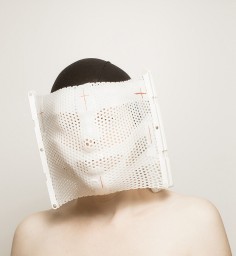Maija Tammi
Leftover
source: wired
AS A CHILD, Maija Tammi wanted to be a pathologist. She doesn’t remember that childhood dream, but her family does. And though she grew up to be an artist, that early fascination with the body informed and shaped her latest project.
The Finnish photographer recently released Leftover/Removals, a collection of stark and clinical images that reflect on the body, disease, and the medical procedures we use to protect the former from the latter. They are difficult to look at, but remarkable to behold—another theme within her work.
“Why is it that the things which disgust us also almost invariably fascinate us at the same time?” she asks.
The book features two distinct but complimentary arcs. Leftover is a series of brightly-lit portraits of a model wearing discarded radiotherapy masks. Removals is a series of dramatic and dark still life images of tissue in stainless steel trays. The series are raw and confrontational, and meant to challenge us.
“We seem to be scared of things that remind us of the fact that we are going to rot and die,” says Tammi. “Even when we know about all the disgusting things inside the human body—blood, snot, intestines—we can still find the sack [the body] that contains it all, beautiful!”
These discomfiting photographs were made as part of Tammi’s doctoral studies at Aalto University School of Arts, Design and Architecture in Helsinki. She started with Removals, working in two hospitals in the city of Tampere to create images meant to “shake up the common ways of seeing everyday things.” Transcribed snippets of conversation between surgeons attempting to deduce what’s shown in each photo take some of the edge off the graphic images.
The images of Leftover were made using radiotherapy masks that a Helsinki hospital gave to her instead of discarding. Here, Tammi draws an interesting parallel between studio portraiture and medical imaging. Photographers set depth of field and light-settings much like a radiographer sets the strength of the x-ray and position of the patient.
As creepy as the portraits may be, they leave you intrigued by the person behind the mask, and what might have happened to her. They are disturbing, but at least there is an identifiable person in the frame. The still lifes of Removals, on the other hand, make it difficult to reconcile that the lump of tissue or limb or gallstone is human.
“To look at these types of images we might at least understand why certain visual depictions of the body disturb us,” says Tammi, who draws inspiration from the likes of Diane Arbus, Hannah Wilke and Raphaël Dallaporta.
Repulsion, fear, and confusion are understandable, even welcome, reactions to Tammi’s work. She isn’t interested in creating images you can ignore.


